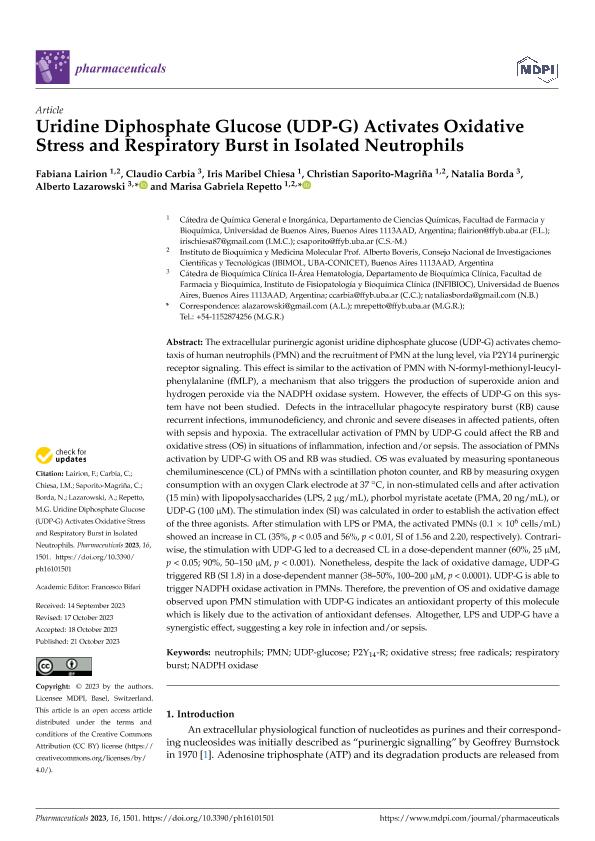Artículo
Uridine Diphosphate Glucose (UDP-G) Activates Oxidative Stress and Respiratory Burst in Isolated Neutrophils
Lairion, Fabiana Norma; Carbia, Claudio; Chiesa, Iris Maribel; Saporito Magriñá, Christian Martín ; Borda, Natalia; Lazarowski, Alberto Jorge; Repetto, Marisa Gabriela
; Borda, Natalia; Lazarowski, Alberto Jorge; Repetto, Marisa Gabriela
 ; Borda, Natalia; Lazarowski, Alberto Jorge; Repetto, Marisa Gabriela
; Borda, Natalia; Lazarowski, Alberto Jorge; Repetto, Marisa Gabriela
Fecha de publicación:
10/2023
Editorial:
MDPI
Revista:
Pharmaceuticals
ISSN:
1424-8247
Idioma:
Inglés
Tipo de recurso:
Artículo publicado
Clasificación temática:
Resumen
The extracellular purinergic agonist uridine diphosphate glucose (UDP-G) activates chemotaxis of human neutrophils (PMN) and the recruitment of PMN at the lung level, via P2Y14 purinergic receptor signaling. This effect is similar to the activation of PMN with N-formyl-methionyl-leucyl-phenylalanine (fMLP), a mechanism that also triggers the production of superoxide anion and hydrogen peroxide via the NADPH oxidase system. However, the effects of UDP-G on this system have not been studied. Defects in the intracellular phagocyte respiratory burst (RB) cause recurrent infections, immunodeficiency, and chronic and severe diseases in affected patients, often with sepsis and hypoxia. The extracellular activation of PMN by UDP-G could affect the RB and oxidative stress (OS) in situations of inflammation, infection and/or sepsis. The association of PMNs activation by UDP-G with OS and RB was studied. OS was evaluated by measuring spontaneous chemiluminescence (CL) of PMNs with a scintillation photon counter, and RB by measuring oxygen consumption with an oxygen Clark electrode at 37 °C, in non-stimulated cells and after activation (15 min) with lipopolysaccharides (LPS, 2 µg/mL), phorbol myristate acetate (PMA, 20 ng/mL), or UDP-G (100 μM). The stimulation index (SI) was calculated in order to establish the activation effect of the three agonists. After stimulation with LPS or PMA, the activated PMNs (0.1 × 106 cells/mL) showed an increase in CL (35%, p < 0.05 and 56%, p < 0.01, SI of 1.56 and 2.20, respectively). Contrariwise, the stimulation with UDP-G led to a decreased CL in a dose-dependent manner (60%, 25 μM, p < 0.05; 90%, 50–150 μM, p < 0.001). Nonetheless, despite the lack of oxidative damage, UDP-G triggered RB (SI 1.8) in a dose-dependent manner (38–50%, 100–200 μM, p < 0.0001). UDP-G is able to trigger NADPH oxidase activation in PMNs. Therefore, the prevention of OS and oxidative damage observed upon PMN stimulation with UDP-G indicates an antioxidant property of this molecule which is likely due to the activation of antioxidant defenses. Altogether, LPS and UDP-G have a synergistic effect, suggesting a key role in infection and/or sepsis.
Archivos asociados
Licencia
Identificadores
Colecciones
Articulos(IBIMOL)
Articulos de INSTITUTO DE BIOQUIMICA Y MEDICINA MOLECULAR
Articulos de INSTITUTO DE BIOQUIMICA Y MEDICINA MOLECULAR
Citación
Lairion, Fabiana Norma; Carbia, Claudio; Chiesa, Iris Maribel; Saporito Magriñá, Christian Martín; Borda, Natalia; et al.; Uridine Diphosphate Glucose (UDP-G) Activates Oxidative Stress and Respiratory Burst in Isolated Neutrophils; MDPI; Pharmaceuticals; 16; 10; 10-2023; 1-14
Compartir
Altmétricas



